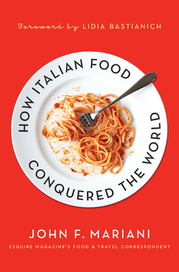Three recent books provide us with quite different ways of looking at the most fundamental element of life: what we eat. Their stories are esepcially relevant as we approach Earth Day, since they touch on how we grow the things we eat. The most ambitious tells the story of America's slow romance with Italy, the most frustrating grew out of a blog about eating at home, and the most satisfying is the memoir of a Seattle restaurateur turned farmer. We'll do one-a-day here; you can read about all three books over on Crosscut.
 Italian food, says John Mariani, has conquered the world. Maybe not the entire globe, but there's little doubt that pizza has become as American as apple pie. Not since Waverly Root wrote "The Food of Italy" in 1953 has there been such a comprehensive look at the contribution Italian cuisine has made to the American way of eating. Mariani's "How Italian Food Conquered the World" probably overstates the geography of the conquest (Italian cuisine is popular in Japan, but has made few inroads in the rest of Asia, Africa or South America.) Still, there's no denying that Italian food has become enormously popular in Europe and North America, and very quickly, too, considering that 100 years ago pasta was considered street food prepared by peasants, to be eaten with the fingers. (Don't believe it? The book has pictures!)
Italian food, says John Mariani, has conquered the world. Maybe not the entire globe, but there's little doubt that pizza has become as American as apple pie. Not since Waverly Root wrote "The Food of Italy" in 1953 has there been such a comprehensive look at the contribution Italian cuisine has made to the American way of eating. Mariani's "How Italian Food Conquered the World" probably overstates the geography of the conquest (Italian cuisine is popular in Japan, but has made few inroads in the rest of Asia, Africa or South America.) Still, there's no denying that Italian food has become enormously popular in Europe and North America, and very quickly, too, considering that 100 years ago pasta was considered street food prepared by peasants, to be eaten with the fingers. (Don't believe it? The book has pictures!)
Of the five million immigrants who came through Ellis Island in the 30 years before the First World War, 80 percent came from southern Italy. At the end of the war, one of every four immigrants who lived in the US had been born in Sicily, having left to escape the grinding poverty of farm life as contadini.
Booker T. Washington, visiting Sicily in 1910, found children working in the mines like slaves, while millions of Italian immigrants, most of them ex-farmers, were lucky to make $10 a week in hostile American cities. Despite the terrible conditions in their homeland, half would return. Those who remained would transform those tenement enclaves into Little Italys.
By 1929, there were more pasta factories in the US than any other country outside of Italy. The first canned sauces were Italian marinara, the classic red tomato sauce. Still, not until 1905 was there a pizzeria in New York, and newspapers in the late 1930s were still explaining that pizza pie wasn't pie.
Seattle, for its part, never had a true "Little Italy" neighborhood, but it did have "Garlic Gulch," the Rainier Valley, of which Remo Borracchino's bakery is the last remaining vestige. Vito's and the Rosellini restaurants were located closer to downtown. An immigrant named Angelo Merlino opened Seattle's first Italian grocery store; his grandson Armandino would open Salumi after his retirement from Boeing. And Armandino's son Mario Batali, well, Mario's version of Italian cooking conquered New York.
Mariani is considered something of a throwback, an old-fashioned, magazine-feature food writer ("Esquire's" annual Best New Restaurants list, for example). Gossipy, chummy with his subjects, he also does extensive, footnoted research (though occasionally inaccurate; the Roman vomitariums were amphitheater exits, not facilities for purging banquet overdoses). He catalogs the Italian names of California wine makers (Gallo, Italian Swiss Colony, Martini, Sebastiani, Trinchero, Mondavi), Italian wines sold in the US (Lambrusco, Riunite, Chill-a-Cella, and Italian-American purveyors of processed food (Hector Boiardi, who became known as Chef Boy-Ar-Dee, Rice-A-Roni, Spaghetti Os).
It's not in the book, but there's a fascinating condensed history on "Esquire's" blog. Some highlights:
There was no Italian pavilion at the 1964 World's Fair even though "La Dolce Vita" had, four years earlier, begun a half-century media campaign orchestrated by the Italian Trade Commission, to glamorize the Italian way of life. Julia Child never mentioned olive oil, but Rachael Ray has made the acronym EVOO part of the language. Fed Ex eventually made overnight delivery of real Parmigiano cheese and Prosciutto di Parma possible. "Under the Tuscan Sun" whipped up fresh appetites for the Italian experience; Olive Garden even promised dinners prepared by chefs who had studied in the village of Riserva di Fizzano.
In Chicago, a tour operator named Karen Herbst put together a loose network of home-based cooking schools in Italy under the name of The International Kitchen, creating a new category of leisure activity for American vacationers. (Note: I'm the company's director of wine tours.) The carbohydrate-phobia induced by the Atkins diet was barely a speed bump in America's love affair with pasta. "Ciao Italiano," on PBS with May Ann Esposito, is the longest-running cocking series on American television. Playwright Neil Simon says that the love of Italian food is a law of the universe. Calvin Trillin suggests replacing the Thanksgiving turkey with spaghetti carbonara.
Leave a comment